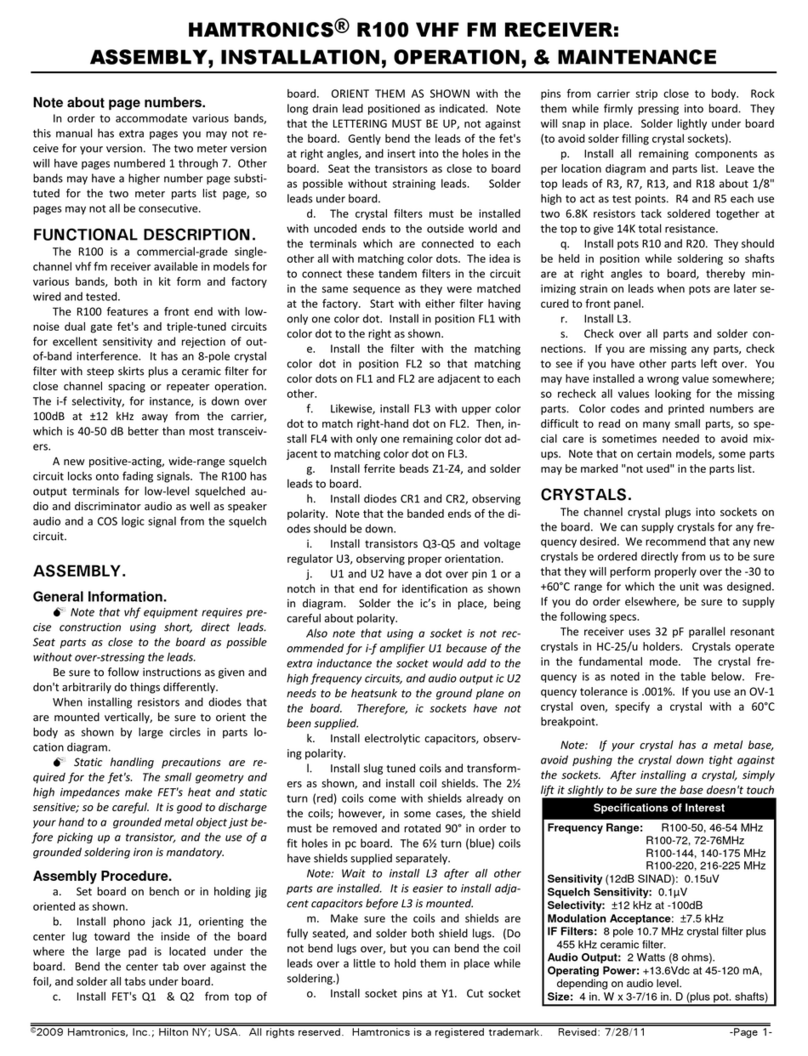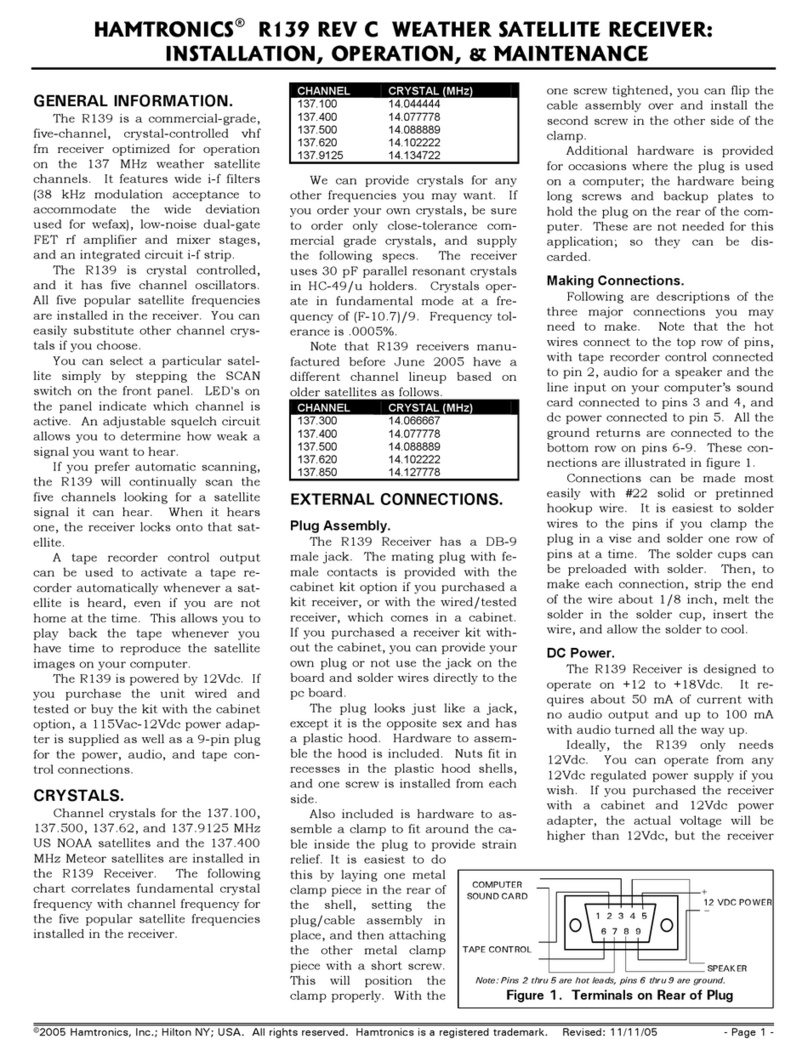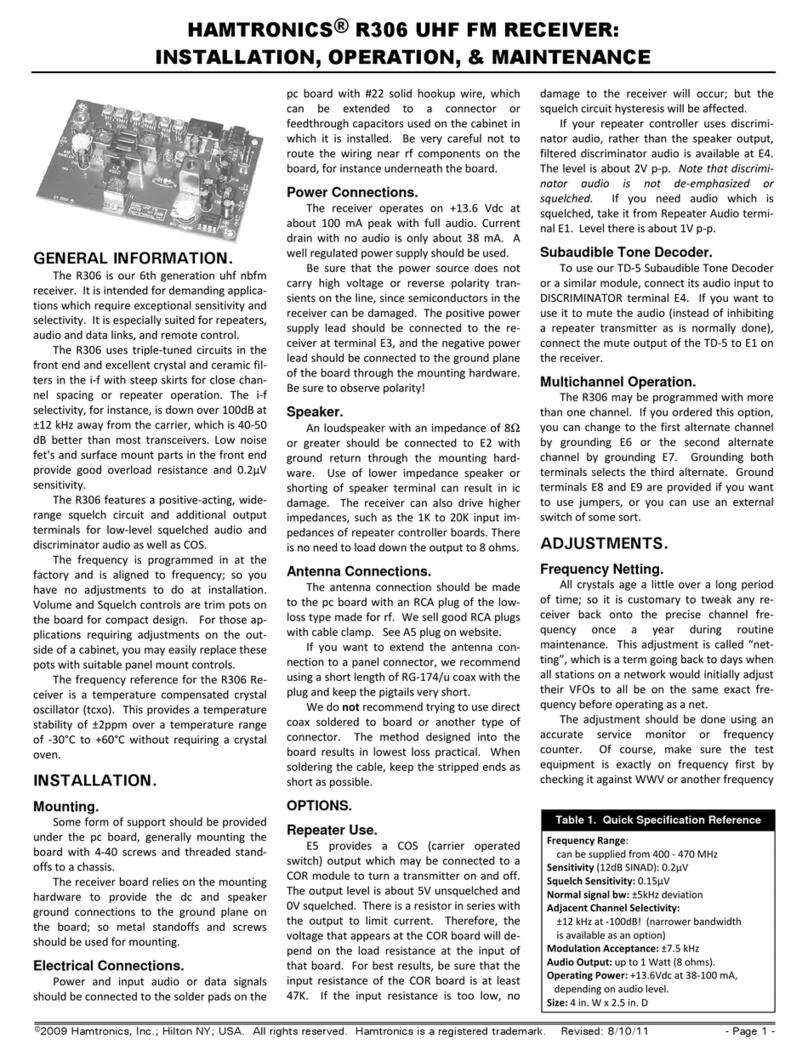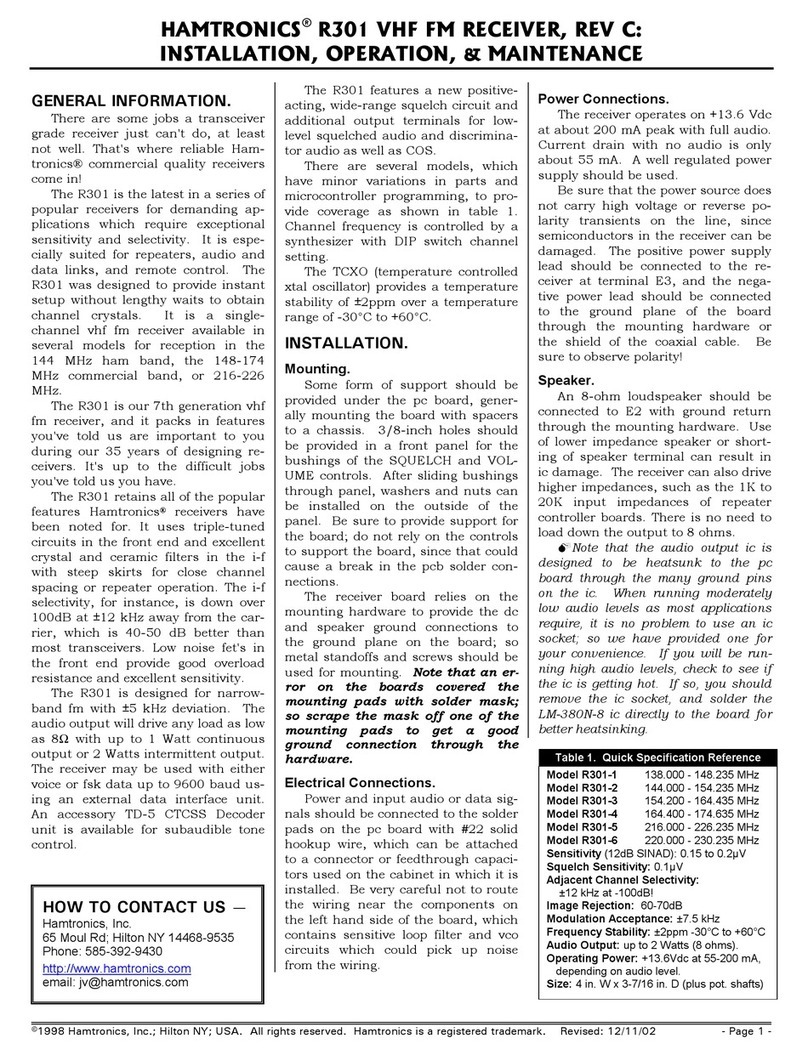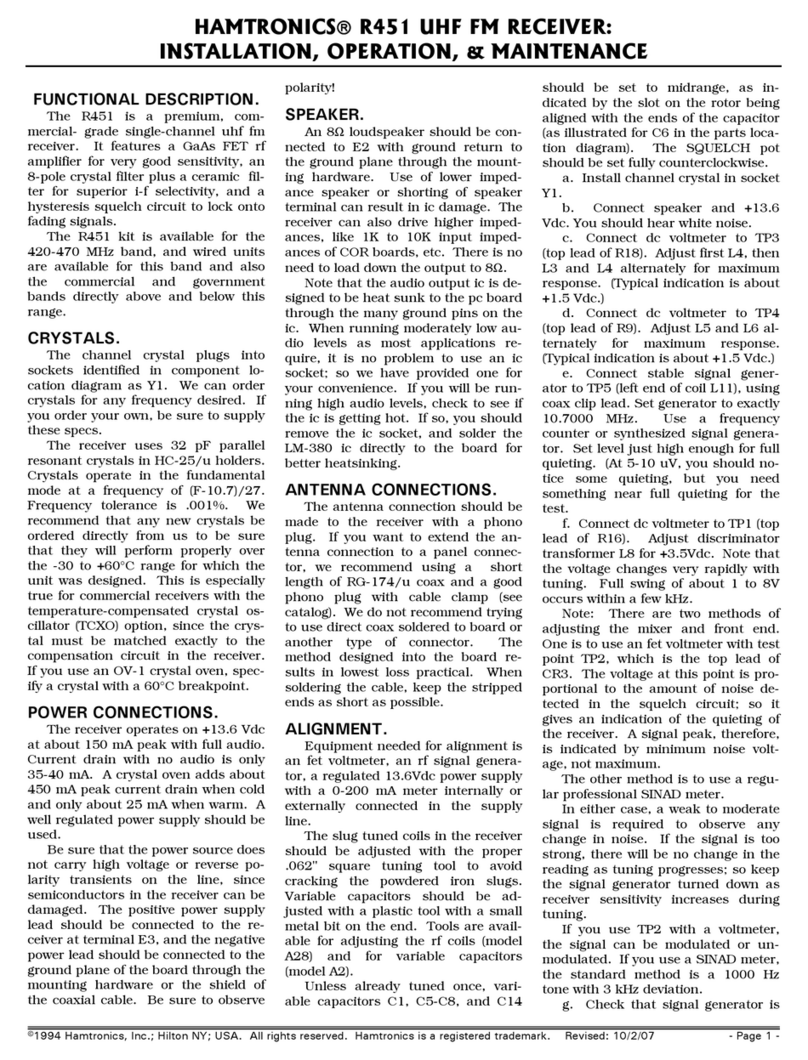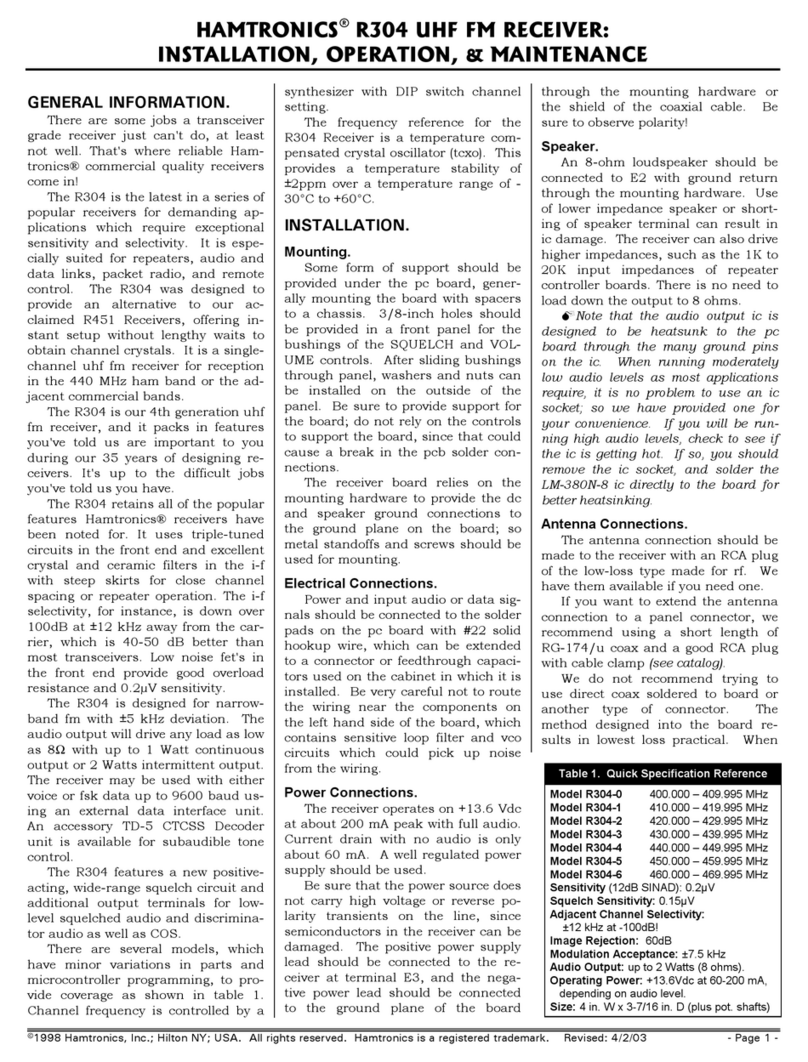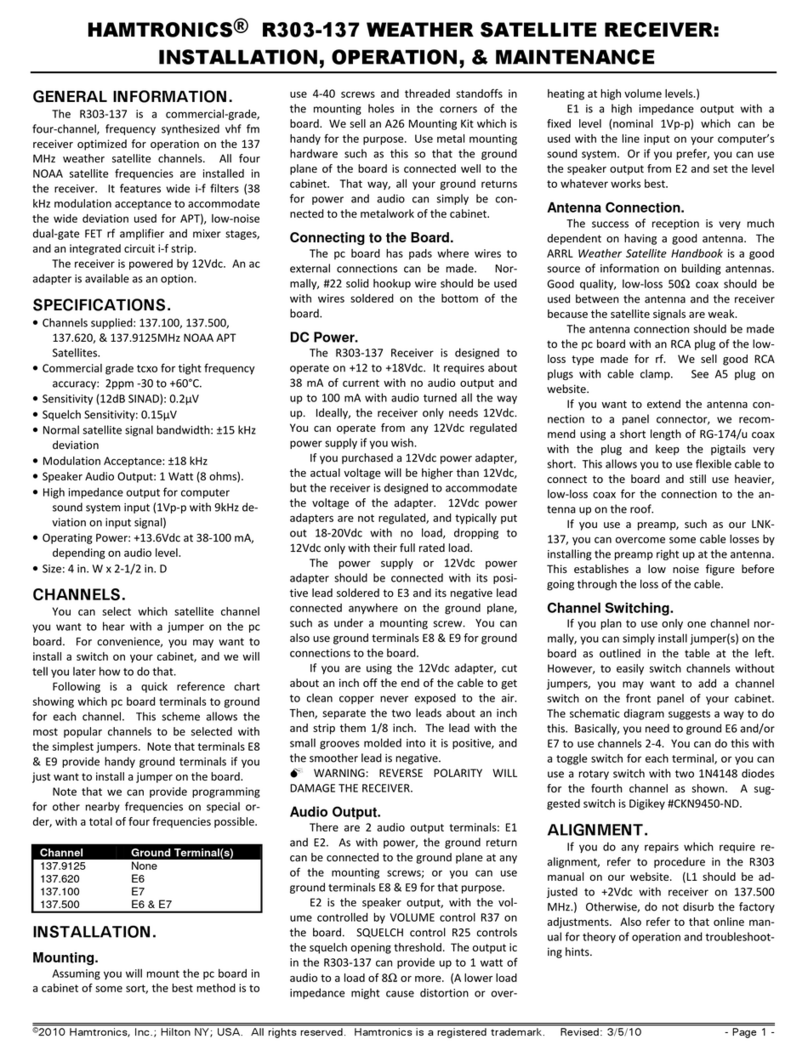
Hamtronics, Inc.; Hilton NY; USA. All rights reserved. Hamtronics is a registered trademark. evised:
the synthesizer needs to know about the
band division schemes reference frequency
and oscillator options is generated by the con-
troller. Information about the base frequency
of the band the receiver is to operate on and
the channel within that band is calculated in
the controller based on information pro-
grammed in the eprom on the controller and
on channel settings done on dip switch S1.
Whenever the microcontroller boots at power
up the microcontroller sends several bytes of
serial data to the synthesizer using the data
clock and /enable lines running between the
two ic’s.
+13.6Vdc power for the Receiver is ap-
plied at E1. Audio output amplifier U5 is
powered directly by the +13.6Vdc. All the
other stages are powered through voltage
regulators for stability and to eliminate noise.
U6 is an 8Vdc regulator to power detector U4
RF amplifier Q4 mixer Q5 and the vco and
buffer. Additional filtering for the vco and
buffer stages is provided by capacitance am-
plifier Q3 which uses the characteristics of an
emitter follower to provide a very stiff supply
eliminating any possible noise on the power
supply line. Regulator U7 provides a +5Vdc
supply for the frequency synthesizer and mi-
crocontroller which are both low current
CMOS devices.
TROUBLESHOOTING.
General.
The usual troubleshooting techniques of
checking dc voltages and signal tracing with
an RF voltmeter probe and oscilloscope will
work well in troubleshooting the R302. DC
voltage charts and a list of typical audio levels
are given to act as a guide to troubleshooting.
Although voltages may vary widely from set to
set and under various operating and measure-
ment conditions the indications may be help-
ful when used in a logical troubleshooting
procedure.
Current Drain.
Power line current drain normally is about
45 mA with volume turned down or squelched
and up to 200 mA with full audio output.
If the current drain is approximately 100
mA with no audio output check to see if volt-
age regulator U6 or U7 is hot. If so and the
voltage on the 8V or 5V line is low there is a
short circuit on that bus somewhere and U6
or U7 is limiting the short circuit current to
100mA to protect the receiver from damage.
If you clear the short circuit the voltage
should rise again. U6 or U7 should not be
damaged by short circuits on its output line;
however it may be damaged by reverse volt-
age or high transient voltages.
Audio Output Stage.
Note that audio output ic U5 is designed
to be heatsunk to the pc board through the
many ground pins on the ic.
If audio is present at the volume control
but not at the speaker the audio ic may have
been damaged by reverse polarity or a tran-
sient on the B+ line. This is fairly common
with lightning damage.
If no audio is present on the volume con-
trol the squelch circuit may not be operating
properly. Check the dc voltages and look for
noise in the 10 kHz region which should be
present at U1-pin 11 with no input signal.
(Between pins 10 and 11 of U1 is an op-amp
active filter tuned to 10 kHz.)
RF Signal Tracing.
If the receiver is completely dead try a
10.700 MHz signal applied to TP-3 using coax
test lead. Set level just high enough for full
quieting. At 1 µV you should notice some
quieting but you need something near full
quieting for the test.
You can also connect the 10.700 MHz test
lead through a blocking capacitor to various
sections of the crystal filter to see if there is a
large loss of signal across one of the filter sec-
tions. Also check the 10.245 MHz oscillator
with a scope or by listening with an hf receiver
or service monitor.
A signal generator on the channel fre-
quency can be injected at various points in the
front end. If the mixer is more sensitive than
the RF amplifier the RF stage is suspect.
Check the dc voltages looking for a damaged
fet which can occur due to transients or re-
verse polarity on the dc power line. Also it is
possible to have the input gate (gate 1) of the
RF amplifier fet damaged by high static
charges or high levels of RF on the antenna
line with no apparent change in dc voltages
since the input gate is normally at dc ground.
Synthesizer Circuits.
Following is a checklist of things to look
for if the synthesizer is suspected of not per-
forming properly.
a. Check the output frequency of the
vco buffer with a frequency counter.
c. Check tuning voltage at TP1. It
should be about +2.0Vdc. Actual range over
which the unit will operate is about +0.5Vdc
to about +4.5Vdc. However for optimum re-
sults the vco should be tuned to allow opera-
tion at about +2.0Vdc center voltage.
d. Check the operating voltage and bias
on the vco and buffer.
e. Check the TCXO at pin 1 of the syn-
thesizer ic. A scope should show strong signal
(several volts p-p) at 10.240 MHz.
f. Check the oscillator at pin 1 of micro-
controller ic U1 with a scope. There should be
a strong ac signal (several volts p-p) at the os-
cillator frequency.
g. The data clock and latch enable lines
between the microcontroller and synthesizer
ic’s should show very brief and very fast activ-
ity sending data to the synthesizer ic shortly
after the power is first applied or a dip switch
setting is changed. Because this happens very
fast it can be difficult to see on a scope. Use
100µSec/div 5Vdc/div and normal trigger.
h. Check the microcontroller to see that
its /reset line is held low momentarily when
the power is first applied. C1 works in con-
junction with an internal resistor and diode in
the ic to make C1 charge relatively slowly
when the power is applied. It should take
about a second to charge up.
i. Check the switch settings to be sure
you have the correct frequency information
going to the microcontroller.
Microphonics, Hum, and Noise.
The vco and loop filter are very sensitive
to hum and noise pickup from magnetic and
electrical sources. Some designs use a
shielded compartment for vco’s. We assume
the whole board will be installed in a shielded
enclosure; so we elected to keep the size
small by not using a separate shield on the
vco. However this means that you must use
care to keep wiring away from the vco circuit
at the right side of the board. Having the
board in a metal enclosure will shield these
sensitive circuits from florescent lights and
other strong sources of noise.
Because the frequency of a synthesizer
basically results from a free running L-C oscil-
lator the tank circuit especially L1 is very
sensitive to microphonics from mechanical
noise coupled to the coil. You should mini-
mize any sources of vibration which might be
coupled to the receiver such as motors. In
addition it helps greatly to prevent the
molded coil from vibrating with respect to the
shield can. Both the coil and can are soldered
to the board at the bottom but the top of the
coil can move relative to the can and there-
fore cause slight changes in inductance which
show up as frequency modulation. Therefore
the factory cements the top of the coil to the
can.
Excessive noise on the dc power supply
which operates the receiver can cause noise
to modulate the synthesizer output. Various
regulators and filters in the receiver are de-
signed to minimize sensitivity to wiring noise.
However in extreme cases such as in mobile
installations with alternator whine you may
need to add extra filtering in the power line to
prevent the noise from reaching the receiver.
Other usual practices for mobile installa-
tions are recommended such as connecting
the + power and ground return lines directly
to the battery instead of using cigarette
lighter sockets or dash board wiring.
To varying degrees whine from the 5kHz
reference frequency may be heard on the sig-
nal under various circumstances. If the tuning
voltage required to tune the vco on frequency
is very high or low near one extreme the
whine may be heard. This can also happen
